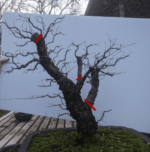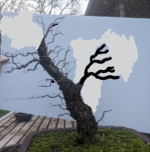RMJoe
Seedling
Picked up this Seiju Elm from a local nursery last fall - it was neglected in a back corner and well priced as a result. Chopped back pretty harshly and repotted into a (too) large bonsai pot. These bud out profusely everywhere, so put on a good number of branches over the year - just wired it out at leaf drop and lightly trimmed back some of the more vigorous tips. Still a ways to go on developing the primary branches, but what do you guys think so far? I like the primary trunk line, but the large sub-trunk branches I am not so sure about since they don't have great movement or taper. I'd love to get opinions on future direction.










